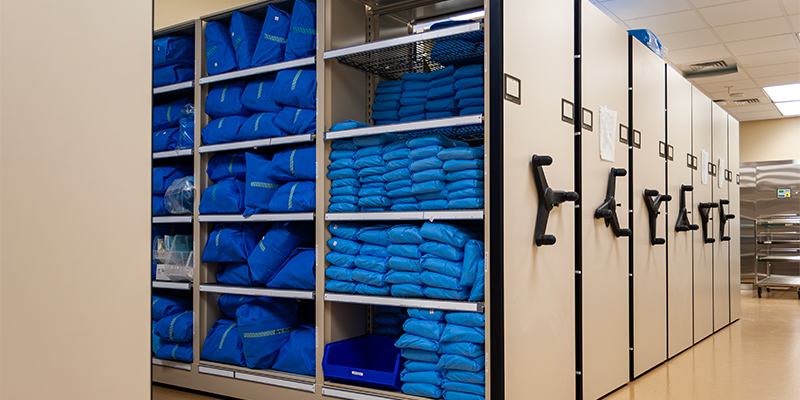You don't usually hear patients talking about the sterile room in a hospital. But that's kind of the point: when a sterile room works properly, it's invisible. Instruments are clean, supplies are stocked, and procedures run smoothly. But when your sterile room isn't set up to support the work, you can feel the effects throughout the whole hospital.
A sterile room, whether it's a sterile processing department, a surgical core, or a supply prep area, is far from just a back-of-house space. It's the behind-the-scenes engine of patient care, and without the right storage, even the best sterile room in a hospital can slow things down.

That was the challenge facing Owensboro Health in Kentucky. As part of a brand-new hospital build, the team knew their sterile processing department (SPD) needed more than just a copy-paste from the old layout. The previous space had been overcrowded, disorganized, and hard to navigate. It wasn't exactly ideal for a hospital that handled more than 60 surgeries a day.

If they wanted better workflows, faster instrument retrieval, and easier staff training, they needed a sterile room designed with purpose. And that purpose starts with better storage. Here's how Owensboro partnered with Patterson Pope to build a sterile room that worked for their hospital, and how they got it right from the ground up.
The Diagnosis: Cluttered, Cramped, and Hard to Navigate
Before the new hospital was built, Owensboro Health's sterile room was...not ideal. Shelves were packed, supplies were scattered, and anyone trying to move through the space had to dodge both carts and coworkers.
The sterile processing department was doing the best it could with wire shelving and a layout that just wasn't built for the volume. Training new staff took way too long. Grabbing the right tray or tool felt like an obstacle course. Keeping the whole area clean felt like a full-time job in itself. And keeping everything sterile in such a cluttered setup? Let's just say it required constant vigilance.

Leadership wanted something better, not just for the sake of space, but for control. They needed to manage supplies, protect materials, and make the sterile room in their hospital easier to navigate, stock, and secure. That meant rethinking how their sterile room was organized, accessed, and used every day.
The Prescription: Custom Sterile Storage
By the time Patterson Pope had joined the Owensboro Health project, only some of the concrete had been poured, which meant we had the rare chance to influence the layout before the walls went up. We started by walking through the old space, dodging carts, bumping into staff, and taking notes on everything that made the previous setup hard to work in.
"We got in at just the right time," said Patterson Pope's Glen Kalley. "What I remember most is how often I was in someone's way. After talking to the client and learning about their goals, we were able to use that experience to craft a new design that would meet their needs."
That design spanned more than just one room. We helped plan storage for the surgical core (with 12 operating rooms), a specialty core (with 4 more ORs for robotics and cath procedures), two labs, maintenance, and even the hospital's medical library.

Solutions included:
- High-density mobile shelving for compact, easy-access storage
- Stainless steel shelving and modular casework tough enough for sterile environments
- Bin shelving to keep tools visible and organized
- Cantilever shelving to maximize flexibility and visibility
- Cage doors to lock down supplies and control who accesses what
This wasn't a cookie-cutter install. It was custom-fit, from floor to ceiling.
The Cure: A Better Sterile Room in the Hospital
Today, the sterile processing department at Owensboro Health feels like a different world. Supplies are easier to find. Training is faster. And the SPD team isn't constantly stepping on each other's toes just to get through a shift. "We have so much more space now," said SPD Manager Chris Edwards. "The maneuverability of the pieces is great because it allows us to make the area truly ours."

Instead of winding through a maze of shelving, staff move freely through a space designed to fit their workflow. Inventory is locked down and more secure, and the layout makes it clear where everything goes (and where everything is). That's made it easier to train new employees and keep things consistent across the board.
"Training has been much easier," Edwards added. "It used to take new folks a long time to learn the layout and how to get around. The SPD staff has always been pretty small, and they think the new space works really well. The whole area is more organized."

Even other hospitals have taken notice. Visitors touring the surgical core have called it "one of the most streamlined cores they've ever seen." But the best part lies in the future-proofing. The space isn't just clean and organized for today, but built to stay that way. As Owensboro's needs shift, the system can shift with them.
How Storage Shapes Safer, Smarter Sterile Rooms
Sterile rooms are high-stakes spaces. Every delay, every detour, every disorganized shelf can affect the speed and quality of care. That's why storage serves as the backbone of sterile spaces. The right setup improves more than inventory. It supports safer workflows, faster training, better ergonomics, and tighter infection control. It helps staff stay focused, not flustered. And it creates space that can keep pace with the people using it.

At Patterson Pope, we've seen firsthand how better storage design can change the way a sterile room functions. It's why we get involved early, ask the right questions, and build solutions that meet your requirements (and your reality).
Planning your own sterile room in a hospital? Let's talk through what's working, what's not, and what's next. Or, start with our Healthcare Storage 101 guide to explore your options.

















